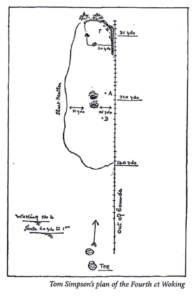Episode 2 from our ‘Story of a Golf Club’ series takes us inland, to the rich sandy and acidic soil of Woking Golf club. Established in 1893 by a number of barristers from New Temple, in the centre of London, Woking was the first heathland golf club in Surrey. Years before, golf was a pastime enjoyed on the British seaside where clubs had originally formed around the South Coast (namely Royal St George’s, Rye) following the games growth in popularity in Scotland, however inland golf was something of a non-event. In London, things were even worse, where eager golfers resorted to using common land in the city, which was often akin to playing on a mud bath for at least half of the year.
Tom Dunn was credited with the initial layout, and in 1893 the club opened for play, and walking the property at Hook Heath, one can only imagine the delight the founding members must have felt, playing on well-draining soil, with firm and fast playing conditions not dissimilar in style to links golf The story gets really exciting at Woking at the turn of the century when two notable members and past captains, (John Low and Stuart Paton) took an interest in the modification of the course. Shortly after 1900, Paton took it upon himself to head out to the 4th fairway, a hole that was relatively bland, short in length, bordering the train line to the right with out of bounds being the only significant obstacle, and dig the two centre line bunkers that still stand today. They didn’t know it at the time, but these two bunkers helped shift the axis of golf course architecture forever, and are often credited as being the first time strategy and decision making was incorporated into the game. The design (often credited as being modelled on the principles nose bunkers on the 16th hole at St Andrews) gave the golfer options….. go right and risk OOB and with that, increase the chances of birdie and accessing the pin with greater ease, or take a safer option short or left of the bunkers and in doing so reduce the scope for a 3.

This generated quite the hullaballoo at Woking in the following years, so much so that fellow member Tom Simpson, on a rainy afternoon went out to inspect the hole and ponder on its merits. He was so taken with the strategic concept, many say it inspired him to quit his career in the legal profession and pursue what turned out to be a successful one in golf architecture. Simpson was often quoted as saying that everything he learnt about course design, he learnt at Woking, and that ‘a golf hole should be more difficult than it looks, or look more difficult than it is’…. Whether Tom just wanted an excuse to get out of his career in law is another matter, but the 4th hole is a monument to strategic course architecture and deserved of its fame around the world.

Woking is greater than the sum of its parts in many respects, with no single standout golf hole, instead it has 18 wonderful holes that all flow well together in a routing that allows you to play from different elevations and see all aspects of the property without being too taxing on the legs. That’s important, because at Woking the club celebrates quick golf, and many of the club members when asked about the current course record, simply reply ‘’2 hours 28 minutes’’. Whether the clock (that sits proudly atop the cricket style pavilion clubhouse and is the clubs iconic logo) is there to remind golfers coming through 14 how they are faring against the Woking equivalent to ‘par’ is another matter.
The history of Woking is incredibly rich, with other greats such as Gerald Micklem, Doug Sewell, Roger Wethered and Bernard Darwin all playing their golf at Woking. It’s easy to see why. Amongst the hustle and bustle of Surrey and a stone’s throw from London, Woking feels like a serene oasis of calm, and whilst pace of play is key, tie seems to stand still while you’re walking among its tall pines and planning your next angle of attack to its wickedly contoured greens.







